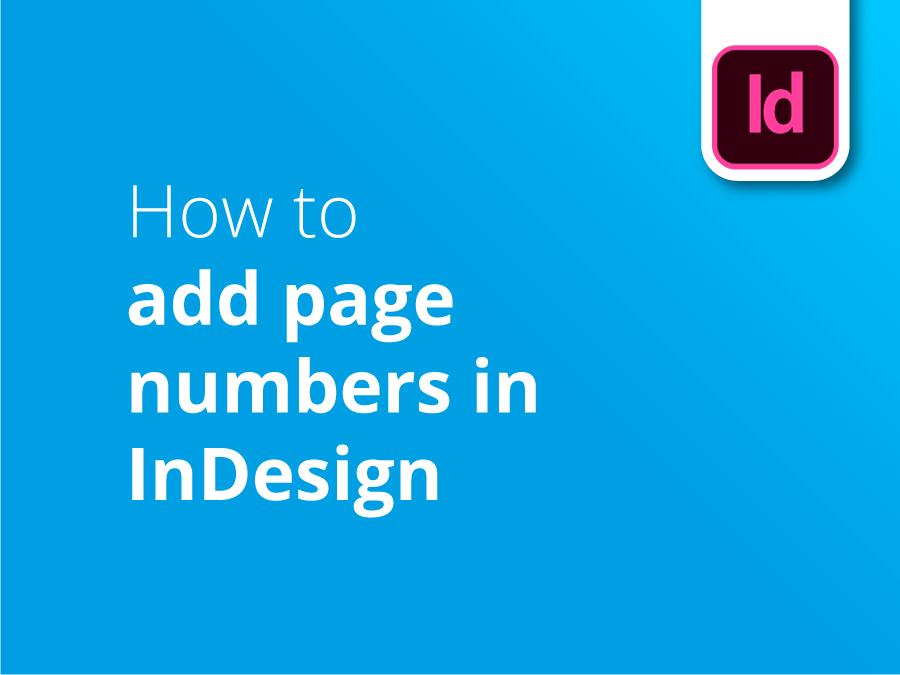InDesign is the go-to graphic design software when it comes to creating multi-page publications. And where there are multiple pages, page numbers always come in handy.
Adding page numbers to your InDesign documents is essential for easy navigation and professional presentation. In this comprehensive guide, we’ll teach you how to add page numbers in InDesign for various document types. Follow our step-by-step instructions to master the process and create well-organized documents with ease.
Step 1: Create a Master Page for InDesign Page Numbers
Before you add page numbers in InDesign, you’ll need to create a master page. Master pages are templates that allow you to apply consistent formatting across multiple pages in your document. This step is crucial for creating a unified appearance when you insert page numbers in InDesign.
1.1 Open the Pages Panel
First, open the Pages panel by navigating to “Window” > “Pages” in the top menu. This panel displays your document’s pages, as well as any master pages you’ve created.
1.2 Create a New Master Page
To create a new master page, click on the “New Master” button located at the bottom of the Pages panel. Name your master page, and click “OK.”
Step 2: Add Page Numbers in InDesign Using the Master Page
Now that you’ve created a master page, it’s time to insert page numbers in InDesign. We’ll use the master page to apply consistent page numbering across your entire document.
2.1 Add a Text Frame
Select the Type Tool from the toolbar, and create a text frame on the master page where you’d like your page numbers to appear. You can place the text frame on the top or bottom of the page, depending on your design preferences.
2.2 Insert the Page Number Marker
With the text frame selected, go to “Type” > “Insert Special Character” > “Markers” > “Current Page Number.” This will add an automatic page number marker (usually displayed as an “A” or “B”) to the text frame.
Step 3: Apply the Master Page to Your InDesign Document
Now that you’ve created a master page with page numbers, it’s time to apply it to your document. This will ensure that your InDesign page numbers appear consistently throughout your project.
3.1 Apply the Master Page to Your Document
In the Pages panel, drag your master page onto the pages you’d like to apply it to. The page numbers will automatically update to match the current page number.
3.2 Customize Page Numbering
If you need to customize the starting page number or numbering style, go to “Layout” > “Numbering & Section Options” in the top menu. Make your desired changes, and click “OK.”
How to Insert Page Numbers in InDesign: Troubleshooting and Tips
While adding page numbers in InDesign is usually straightforward, you may encounter some issues. Here are a few tips to help you troubleshoot and optimize your InDesign page numbers:
- Make sure the text frame containing the page number is large enough to accommodate the number. If it’s too small, the page number may not be visible.
- If your document has multiple sections, ensure that each section has its own master page with unique page number markers. This will help maintain consistent formatting throughout your document.
- When working with facing pages, create separate master pages for left and right pages, and apply the appropriate master page to each side. This ensures that page numbers appear consistently on the correct side of the spread.
- If you need to skip numbering on specific pages (such as title pages or chapter dividers), apply a different master page without a page number marker to those pages.
- To edit the appearance of your page numbers (font, size, color, etc.), simply modify the text frame on the master page. All pages using that master will update automatically.
Video Tutorial: How to add page numbers in InDesign
To make adding page numbers in InDesign even more straightforward, our Senior Graphic Designer, Matt Bruty, has created this video tutorial to help you understand the process.
Bu eğitimi beğendiyseniz, YouTube Kanalımıza buradan abone olduğunuzda keşfedebileceğiniz bir dizi var:
When it’s time to send your publication to print, Solopress offer high-quality print over a range of paper stocks on Broşürler veya Dergiler.
Video Transkripsiyonu
In this Solopress tutorial, I’m going to give you five easy steps for adding page numbering and section naming in InDesign. Let’s take a look.
Step 1: Designing Page Numbers
When setting up automatic numbering on InDesign, you have to do it in your Masters pages, but you’ll see at the moment I haven’t got any numbering set up. That’s because I always like to start with designing the numbering on an actual page that’s got some design work on it just so you can get a feel for how it’s going to sit within the design.
Another thing I would recommend is having your own layer for the page numbers, so you can keep it separate and be organized. Right, so I’m happy with this design that I’ve created for this page, and it’s basically going to show you the page number, and also I want the name to change depending on what section of the book I’m in.
What I can do once I’m happy with the design is copy it and delete it. I don’t need it there anymore. And I can go to our Masters page and paste it in place, and now it’s a case of setting this up to be automated.
Now there’s a lot more to page numbering than you may realize, so please stick around through these quick steps and you’ll be well-armed for future projects.
Step 2: Adding Special Characters
In my Masters, I’ve just added another page number on the other side, and I’ve switched the page, the section name and the page number and right-aligned it. Now we need to add the special characters to these to make them automatic.
What you do, you highlight your page number, go up to Tip, come down to, Insert Special Character, add a Markerve Current Page Number. And then for the section name, again we go to the same place, Tip, Insert Special Character, Marker, but this time put the Section Marker in.
I’m going to do the same over this side. So, Section Marker, go to Tip, Insert Certain Special Character, Markers, Section Marker, and this one for the page numbers: Tip, Insert Special Character, Marker, Current Page Number.
And then when I click on one of our pages in our design, you can see that it’s updated it to the page we’re on. If I click on page five, there we go, page five. And you’ll notice the section name is missing. That’s because we need to set that up in our next step.
Step 3: Defining Sections
To define our sections so they appear down here, I need to do that within these thumbnails here, but before I do that there’s one important thing to do.
Where there are any spreads that you don’t want to be disturbed, I just select all the pages, and then come up to your menu, and just make sure this one’s unchecked that allows Selected Spreads To Shuffle. I don’t want that to happen, I want them to always stay as spreads. If I didn’t do that, it would start shifting pages along and we’d end up in a bit of a mess.
Anyway, so what we do, we’re going to start a new section here on page two, our “Gulls” page. We’re going to right-click, come down to Numbering & Sections Options, and automatically it will start a new section, so that’s checked, and then you’ve got two options. You can either automatically page number, so it’ll recognize these page numbers here and update it like that, or you can start new page numbering for each section, and I’m going to do that so every section I’ve got, I’m going to start at page one.
And then here, I’ve got this bit here – Section Prefix – this is my first section, so I’m going to call it “a”, and all that means is it will show me a little “a” here, so when I’m getting organized in my thumbnails, I can see what section I’ve got. You can also include that prefix here by checking on this box, which is Include Prefix When Numbering Pages. But I don’t want that – I don’t want there to be an “a” before my number.
And then style of numbering, you’ve got these options here, even Roman numerals, but I’m going to just stick with normal numbering for this one. And section marker, that’s the name of our section and so we’re going to call this one “Gulls”. And then I can OK that, and you can see that it’s updated, so we’re in page one of “Gulls”. And if I come across here, page two of “Gulls”, and if you come down to this new section, “Stacks”, you’ll see it’s still called “Gulls”. That’s because we need to define the new section for the “Stacks”.
You’ll notice as well, these little arrows that appear above the thumbnails, this is showing you where a new section starts. So let’s just quickly do this one as well then. This is going to be our “Stacks” section. I’m going to right-click, Numbering & Sections Options. Yes, I want to start a new selection. Yes, I want to start page numbering at one again for my new section. Section Prefix, I’m going to call this one “b”, because it’s my second section. And that’s going to change this “a” here to a “b”. I’m going to stick with normal numbering. And this section marker, I’m going to call “Stacks”. Click OK.
And I go to my “Stacks” page. You can see that I’m on page one of “Stacks”, and then “Stacks” page two. And you’ll see on this page, we’ve got a dark background. We’re going to come to that in a minute, how we’re going to fix that.
But what you can do now, you’ve got this setup – say I wanted another four pages within my “Stacks” section – this is my “Stacks” section “b”. I can insert some pages, and it’ll update all the page numbers. If I go Insert Pages, and I’m going to go After Page “b2”, so it’s going to be after this page. And I want another four pages in that section. And at the moment I’ve only got one Master, A-Master. So if I click OK, it’s put in four new pages and they should all be numbered correctly to be in “Stacks”. So this should be number three “Stacks”, “Stacks” number four, and so on.
So the beauty of this is when you’ve got, when you’ve got your booklet design and as and when you’re adding pages, it’s just always going to automatically update the name of the section and the page number.
Step 4: Managing Pages without Numbering
Going back to our dark page here, obviously, we can’t see these page numbers, but we’ve got two options here.
You might decide that you don’t want page numbering on these ones, or for example, you might have an advert in your magazine and you don’t have page numbering there. So all you can do is pull down this Master page that says none, and you can put that onto the page and it will just, it will just take away the page numbering.
But I don’t want to do that. I want this to be seen on this page. So what I’m going to do is create another, a duplicate of this Master page, and basically just make it white. I’m going to select both these pages, duplicate Master spread A, and then all I’m going to do, I’m going to keep the line red, but I’m going to change the style of these letters to white. Same for this side. So they’re updated.
Now I can either drag those down individually onto this page, or I can select both these pages, and then Apply Masters To Pages. So “c1” and “c2”, that’s those pages, but I want those to be the B-Master. Click OK, and it’s fingers crossed – there you go!
So this section is called light, and that’s page one of light. Hang on, let me just hide my guides. That’s page one of light, that’s page two of light, and then so on and so forth, I can add more pages.
Step 5: Further Tips
If you think there’s anything you could add, please share your knowledge in the comments below for fellow viewers, and don’t forget, we’re adding to the channel all the time if you want to subscribe. As always, we appreciate your likes and comments, and thanks for watching, and we’ll see you for the next one.




